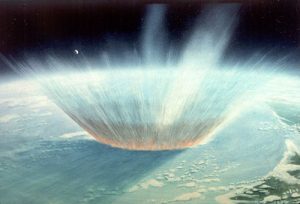
On April 14, scientists will begin collecting new samples from the Chicxulub impact crater, remnant of an asteroid that crashed into Earth 66 million years ago and caused the extinctions of 75 percent of the planet’s species, including the dinosaurs. The international team includes two Penn State researchers, Tim Bralower, professor of geosciences, and Heather Jones, Ph.D. candidate in geosciences.
Scientists theorize that a 6-mile-wide asteroid struck the Earth on Mexico’s Yucatan Peninsula, resulting in a chain of events—global darkness, nuclear winter, ocean acidification and rampant wildfires—that wiped out nearly all life. The asteroid struck Earth with more than a billion times the energy of an atomic bomb, researchers estimate, and melted the rock at ground zero.
The International Ocean Discovery Program (IODP) research team hopes to learn new details about how life persisted following the impact. Team members also hope to better understand the mechanics of the crash, such as how rapidly temperature changed after impact, the angle at which the asteroid struck the Earth and how the bedrock behaved under such intense pressure.
Stationed on a drilling rig 25 miles off the coast of Mexico, the team will collect samples from the circle-shaped perimeter, known as the ‘peak ring,’ of the Chicxulub impact crater. The Chicxulub crater is the only known impact crater on Earth with an intact peak ring, and it is the only crater that has been linked to a mass extinction.
“I’m excited to be part of the project because it’s the first time that anyone has collected samples from the crater’s peak ring,” said Bralower. “Deep underneath the peak ring is a geological layer called the melt layer. This layer shows evidence of widespread melting at the time of the crash, and this melting was a critical part of the extinction process because it led to a global rainout of tiny melt droplets that caused wildfires.”
Bralower will be on board the drilling rig to conduct initial analyses of the samples as the IODP team digs. Once the cores have been extracted, the team will transport them to IODP’s Bremen Core Repository in Germany. Jones will travel to Germany in September to help the team conduct a detailed analysis of the cores.
To collect their samples, the team has to dig through layers of sediment that have built up on top of the melt layer. They are looking for signs of life and other geological information from between 55 and 66 million years ago. They will first dig 0.3 miles under the ocean floor to the layer of sediment that was deposited roughly 55 million years ago. From there, they aim to collect cores dating back to 66 million years ago, and this is where Bralower’s expertise comes into play. He will conduct microscopic analyses on each sample collected at 20- to 30-foot intervals to date the time period of the sediment. To access the sediment deposited 66 million years ago, the team will need to drill a total of 0.5 miles under the sea floor.
“This is really my bread and butter,” Bralower said. “Every time we bring a new piece of core up, we’ll take a crumb and look at it under a microscope. Based on the fossils we find, we’ll know how old the sample is.”
Bralower will be looking specifically for phytoplankton fossils because they are easy to prepare and analyze on the ship. Because phytoplankton are at the bottom of the food chain, analyzing their distribution through the 11-million-year interval could help researchers better understand how quickly life recovered after the impact.
The international team includes scientists from Mexico, Japan, Australia, Canada, China and six European countries.
This work is being supported by the International Continental Scientific Drilling Program and the European Consortium for Ocean Research Drilling.
Note: The above post is reprinted from materials provided by Pennsylvania State University.










